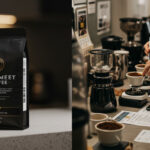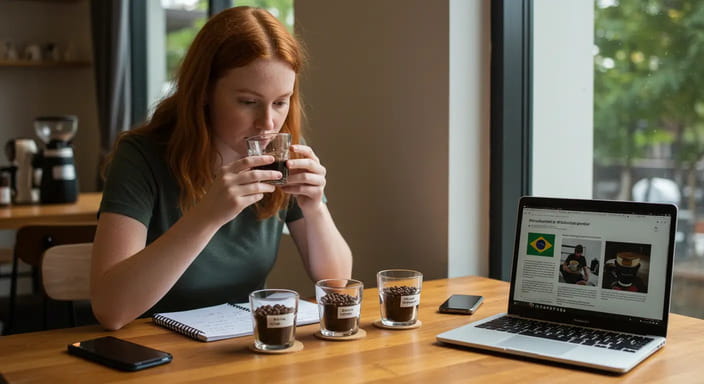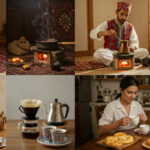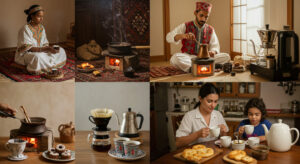
What Makes Coffee “Special”?

Table of Contents
ToggleSpecialty coffee, often referred to as special coffee, is not just a cup of joe—it’s an experience. Unlike mass-produced coffee, specialty coffee is meticulously crafted from farm to cup. It starts with high-quality Arabica beans, grown in ideal climates and harvested at peak ripeness. These beans are then carefully roasted to highlight their unique flavor profiles, which can range from floral and fruity to nutty and chocolatey.
What truly sets specialty coffee apart is its focus on quality, transparency, and sustainability. Every step of the process is intentional, from the farmer’s cultivation practices to the barista’s brewing technique. This dedication ensures that every sip delivers a distinct and memorable taste.
Why Quality Evaluation Matters
Evaluating the quality of specialty coffee is essential for both producers and consumers. For producers, it ensures that their hard work meets industry standards and helps them earn fair recognition and pricing. For consumers, it guarantees that you’re getting the best possible cup of coffee.
The Specialty Coffee Association (SCA) has established a rigorous grading system based on factors like aroma, flavor, acidity, body, and aftertaste. Coffees scoring 80 points or above on a 100-point scale are considered specialty grade. By understanding these criteria, you can:
- Appreciate the nuances of different coffee varieties.
- Make informed purchasing decisions.
- Elevate your brewing skills to match the quality of the beans.
Ultimately, evaluating coffee quality isn’t just about taste—it’s about fostering a deeper connection to the art and science behind every brew.
Key Factors to Evaluate Coffee Quality
Origin and Growing Conditions
Where coffee is grown plays a pivotal role in determining its flavor profile. The altitude, soil composition, and climate of the region all influence the beans’ characteristics. High-altitude coffee, for instance, often boasts a more complex and vibrant taste due to slower bean maturation. Countries like Ethiopia, Colombia, and Kenya are renowned for their unique growing conditions, each contributing to distinct flavor notes such as floral, fruity, or earthy tones. When evaluating coffee quality, understanding its origin can provide insight into what to expect in your cup.
Processing Methods
How coffee cherries are processed after harvesting significantly impacts the final flavor. There are three primary methods: washed, natural, and honey. Washed processing yields a clean, bright cup with pronounced acidity, as the fruit is removed before drying. Natural processing, on the other hand, involves drying the cherries whole, resulting in a sweeter, fruitier flavor. Honey processing strikes a balance between the two, offering a nuanced sweetness and body. The method used can reveal much about the coffee’s quality and taste.
Freshness and Roast Date
Freshness is a cornerstone of exceptional coffee. The roast date is one of the most critical indicators of quality, as coffee begins to lose its aromatic compounds and flavor complexity soon after roasting. For the best experience, aim to brew your coffee within 2-4 weeks of the roast date. Storing beans in an airtight container, away from light, heat, and moisture, can help preserve their freshness. Remember, the closer you are to the roast date, the more vibrant and rich your coffee will taste.
Sensory Evaluation Techniques
Aroma: The First Impression
When evaluating specialty coffee, aroma is your first gateway to understanding its quality. As you bring the cup to your nose, take a moment to inhale deeply. Aroma can reveal a lot about the coffee’s origin, roast level, and freshness. Look for complex scents—ranging from floral and fruity to nutty or chocolaty. A vibrant, aromatic profile often indicates a well-crafted coffee. Remember, if the aroma feels flat or stale, it might be a sign of poor quality or improper storage.
Flavor Profile: Identifying Notes
Next, take a sip and let the coffee coat your tongue. The flavor profile is where specialty coffee truly shines. Train your palate to identify distinct notes, whether they’re bright citrus, sweet berries, or earthy spices. Here’s a quick guide to help:
- Fruity: Commonly found in African coffees, with hints of berries or stone fruits.
- Floral: Often present in lightly roasted coffees, with delicate jasmine or hibiscus notes.
- Chocolaty/Nutty: Frequently found in Latin American coffees, offering rich, comforting flavors.
Don’t worry if you can’t pinpoint every note right away—palate development takes time and practice!
Acidity, Body, and Aftertaste
To fully evaluate coffee, you’ll want to consider three key elements:Acidity: Acidity refers to the brightness or liveliness of the coffee. It’s not about sourness but rather a tangy, refreshing quality. A well-balanced acidity can elevate the coffee’s complexity. Body: Body describes the weight and texture of the coffee on your palate. It can range from light and tea-like to full and creamy. Specialty coffee often has a refined, medium body that complements its flavor profile. Aftertaste: The aftertaste, or finish, is the final impression the coffee leaves. A lingering, pleasant aftertaste is a hallmark of high-quality coffee. If the finish feels dull or unpleasant, it might indicate flaws in the brew or beans.
Brewing Methods and Their Impact
How Brewing Affects Taste
The brewing method you choose plays a pivotal role in shaping the flavor, aroma, and overall experience of your coffee. Each technique extracts different compounds from the coffee grounds, influencing attributes like acidity, body, and sweetness. For instance, espresso delivers a concentrated, bold flavor with a creamy texture, while pour-over methods highlight the delicate nuances and bright acidity of specialty beans. Understanding these differences is essential for evaluating the quality of your coffee and appreciating its unique characteristics.
Choosing the Right Method for Evaluation
Selecting the appropriate brewing method is crucial when assessing the quality of specialty coffee. Here are some popular methods and their suitability for evaluation:
- Pour-Over (e.g., V60, Chemex): Ideal for highlighting clarity, acidity, and floral or fruity notes. It allows for precise control over extraction, making it a favorite among coffee connoisseurs.
- French Press: Known for its full-bodied, rich flavor. It’s great for evaluating the coffee’s natural oils and robust characteristics but may mute subtle notes.
- Espresso: Perfect for assessing intensity, balance, and crema. It’s a reliable method for evaluating the coffee’s complexity in a concentrated form.
- AeroPress: Versatile and forgiving, it can mimic the characteristics of both pour-over and espresso, making it suitable for a broad range of evaluations.
When evaluating coffee, consider using multiple brewing methods to get a well-rounded understanding of its profile. This approach ensures that you don’t miss out on any hidden flavors or qualities that might shine through in a particular method.
Tips for Consistent Evaluations
Consistency is key when using brewing methods for evaluation. Here are some tips to ensure accurate results:
- Use the same grind size and water temperature for each method to maintain uniformity.
- Follow a standardized brewing ratio (e.g., 1:16 coffee to water) to avoid over- or under-extraction.
- Keep notes on extraction time, flavor notes, and perceived balance to track differences between beans or methods.
By mastering these techniques, you’ll be better equipped to appreciate and evaluate the intricate flavors of specialty coffee.
Common Coffee Defects and How to Spot Them
Off-flavors and Their Causes
One of the most telling signs of a defective coffee is the presence of off-flavors. These unpleasant tastes can stem from various issues during the growing, processing, or brewing stages. Here’s a breakdown of common off-flavors and their likely causes:
- Sourness: Often the result of under-extraction, sour coffee may also indicate underripe beans or improper fermentation during processing.
- Bitterness: Over-extraction or over-roasting can lead to excessive bitterness, as can the use of low-quality or stale beans.
- Papery or Stale: This flavor typically arises from aged or improperly stored coffee, which loses its freshness over time.
- Fermented or Musty: These flavors are usually caused by improper drying or storage, leading to mold or bacterial growth.
- Earthy or Muddy: Often associated with poor processing methods, such as over-fermentation or contamination during drying.
Visual Indicators of Poor Quality
While taste is the ultimate guide, visual cues can also help you identify subpar coffee before brewing. Keep an eye out for these red flags:
- Uneven Roast: Beans with inconsistent coloration suggest poor roasting techniques, which can lead to imbalanced flavors.
- Cracks or Chips: Damaged beans can indicate mishandling during processing or transport, often resulting in off-flavors.
- Dull Appearance: Fresh, high-quality beans typically have a glossy sheen. Dull or matte beans may be stale or of lower quality.
- Excessive Chaff: While some chaff is normal, an abundance of it in your grounds can suggest improper processing or cleaning.
Tips for Enhancing Your Coffee Experience
Proper Storage for Freshness
Maintaining the freshness of your coffee is paramount to enjoying its full potential. Once roasted, coffee beans are at their peak for only a short period. Air, light, moisture, and heat are the four main enemies of coffee freshness. To preserve your beans:
- Store coffee in an airtight container, preferably one with a valve that allows gases to escape without letting air in.
- Keep the container in a cool, dark place, away from direct sunlight or heat sources like stoves or ovens.
- Avoid freezing or refrigerating your beans unless you plan to use them over an extended period. Condensation can compromise the flavor.
- Purchase coffee in smaller quantities, ideally enough for 1-2 weeks, to ensure you’re always brewing with fresh beans.
Investing in Quality Equipment
The tools you use to brew your coffee can make a significant difference in the final cup. While it’s tempting to cut corners, investing in quality equipment ensures consistency and elevates your coffee experience. Here’s what to consider:
- Grinder: A burr grinder is essential for achieving a consistent grind size, which directly impacts extraction and flavor. Blade grinders, while cheaper, often produce uneven grounds that can lead to over- or under-extraction.
- Brewing Method: Whether you prefer pour-over, French press, espresso, or a drip machine, choose a method that aligns with your taste preferences. High-quality brewing devices often feature better materials and design, resulting in a more controlled and enjoyable process.
- Water Quality: Coffee is 98% water, so using filtered or high-quality water can drastically improve taste. Avoid overly hard or soft water, as it can alter the flavor profile.
- Accessories: Items like a digital scale, gooseneck kettle, and thermometer might seem like extras, but they help you achieve precision and repeatability in your brewing process.
Final Thoughts and Recommendations
Practicing Mindful Tasting
Evaluating the quality of specialty coffee is as much about technique as it is about palate. Mindful tasting is a practice that allows you to fully appreciate the nuances of your coffee. Here’s how to get started:
- Focus on the aroma: Before sipping, take a moment to inhale deeply. The aroma often hints at the flavor profile.
- Slurp, don’t sip: Slurping aerates the coffee, spreading it across your palate to fully capture its flavors.
- Take notes: Jot down your observations on acidity, sweetness, body, and aftertaste. This helps refine your palate over time.
Mindful tasting not only enhances your appreciation of coffee but also helps you identify the subtle characteristics that define a truly exceptional brew.
Exploring Different Coffee Varieties
One of the joys of specialty coffee is the vast array of varieties available. Each coffee origin and processing method brings unique flavors to the cup. Here are a few recommendations to broaden your coffee horizons:
- Ethiopian Yirgacheffe: Known for its floral and citrus notes, this coffee is a must-try for those who enjoy bright, complex flavors.
- Colombian Supremo: With its balanced acidity and nutty undertones, this variety is a crowd-pleaser.
- Sumatra Mandheling: A bold, earthy coffee with a rich body, perfect for those who prefer darker, more robust profiles.
Don’t be afraid to experiment. Try single-origin coffees, blends, and experimental processing methods to discover what resonates with your palate.
Final Recommendations
To truly elevate your coffee experience, consider the following:
- Invest in quality equipment: A good grinder and brewing setup can make a world of difference.
- Source fresh beans: Look for roasters who provide roast dates and prioritize freshness.
- Engage with the community: Join coffee workshops or online forums to learn from fellow enthusiasts.
Ultimately, the journey of evaluating and enjoying specialty coffee is deeply personal. Trust your palate, stay curious, and savor every sip.
is an editor at Coffee With Finance and a true coffee enthusiast. He explores roasts, flavors, origins, and brewing methods, sharing stories that captivate both beginners and experts. Petter believes great coffee sparks meaningful moments—and that includes simple, jargon-free talks about personal finance. His content blends aroma, flavor, and insight, making each coffee break an inspiring and enriching experience.




























Post Comment